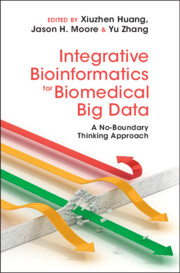Book contents
- Integrative Bioinformatics for Biomedical Big Data
- Integrative Bioinformatics for Biomedical Big Data
- Copyright page
- Dedication
- Contents
- Contributors
- 1 No-Boundary Thinking
- 2 Artificial Intelligence Approaches to No-Boundary Thinking
- 3 No-Boundary Thinking in Undergraduate Bioinformatics Education
- 4 No-Boundary Course Developments
- 5 No-Boundary Thinking for Transcriptomics and Proteomics Big Data
- 6 Pharmacogenomics
- 7 The Ethical Status of an AI
- 8 Computational Thinking and No-Boundary Thinking
- 9 Carving Nature at the Joints: Which Joints?
- Index
- References
2 - Artificial Intelligence Approaches to No-Boundary Thinking
Published online by Cambridge University Press: 14 September 2023
- Integrative Bioinformatics for Biomedical Big Data
- Integrative Bioinformatics for Biomedical Big Data
- Copyright page
- Dedication
- Contents
- Contributors
- 1 No-Boundary Thinking
- 2 Artificial Intelligence Approaches to No-Boundary Thinking
- 3 No-Boundary Thinking in Undergraduate Bioinformatics Education
- 4 No-Boundary Course Developments
- 5 No-Boundary Thinking for Transcriptomics and Proteomics Big Data
- 6 Pharmacogenomics
- 7 The Ethical Status of an AI
- 8 Computational Thinking and No-Boundary Thinking
- 9 Carving Nature at the Joints: Which Joints?
- Index
- References
Summary
The goal of this chapter is to explore and review the role of artificial intelligence (AI) in scientific discovery from data. Specifically, we present AI as a useful tool for advancing a No-Boundary Thinking (NBT) approach to bioinformatics and biomedical informatics. NBT is an agnostic methodology for scientific discovery and education that accesses, integrates, and synthesizes data, information, and knowledge from all disciplines to define important problems, leading to innovative and significant questions that can subsequently be addressed by individuals or collaborative teams with diverse expertise. Given this definition, AI is uniquely poised to advance NBT as it has the potential to employ data science for discovery by using information and knowledge from multiple disciplines. We present three recent AI approaches to data analysis that each contribute to a foundation for an NBT research strategy by either incorporating expert knowledge, automating machine learning, or both. We end with a vision for fully automating the discovery process while embracing NBT.
Keywords
- Type
- Chapter
- Information
- Integrative Bioinformatics for Biomedical Big DataA No-Boundary Thinking Approach, pp. 5 - 24Publisher: Cambridge University PressPrint publication year: 2023

